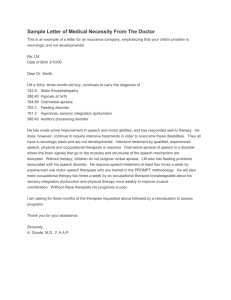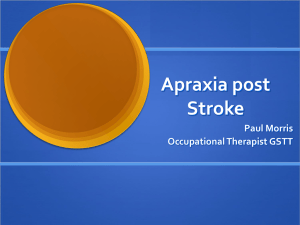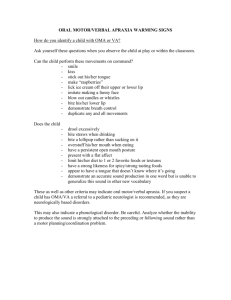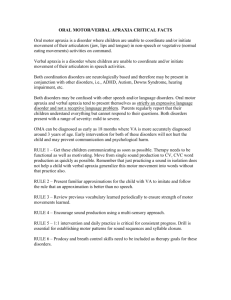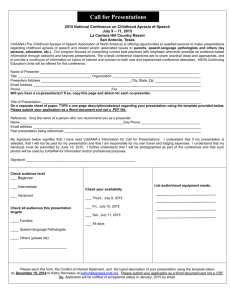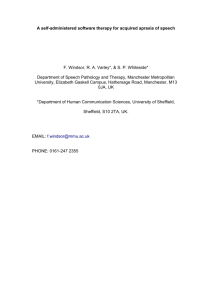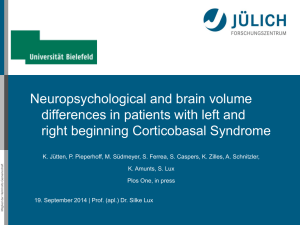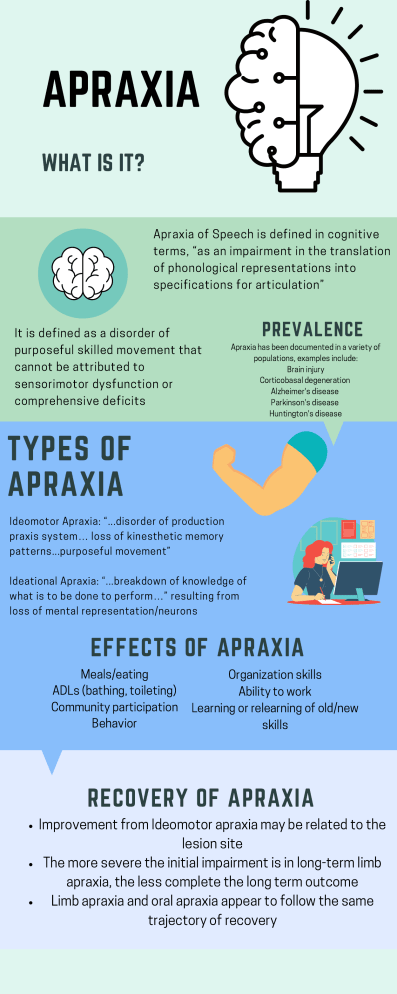
APRAXIA WHAT IS IT? Apraxia of Speech is defined in cognitive terms, “as an impairment in the translation of phonological representations into specifications for articulation” It is defined as a disorder of purposeful skilled movement that cannot be attributed to sensorimotor dysfunction or comprehensive deficits PREVALENCE Apraxia has been documented in a variety of populations, examples include: Brain injury Corticobasal degeneration Alzheimer's disease Parkinson's disease Huntington's disease TYPES OF APRAXIA Ideomotor Apraxia: “...disorder of production praxis system… loss of kinesthetic memory patterns...purposeful movement” Ideational Apraxia: “...breakdown of knowledge of what is to be done to perform…” resulting from loss of mental representation/neurons EFFECTS OF APRAXIA Meals/eating Organization skills ADLs (bathing, toileting) Ability to work Community participation Learning or relearning of old/new Behavior skills RECOVERY OF APRAXIA Improvement from Ideomotor apraxia may be related to the lesion site The more severe the initial impairment is in long-term limb apraxia, the less complete the long term outcome Limb apraxia and oral apraxia appear to follow the same trajectory of recovery RECENT TREATMENT Use tactile (touch) and kinesthetic stimulation (this means how your body is positioned in space) in addition to visual and verbal mediation input (deep pressure, sharp touch input. soft touch, self-touch, proprioceptive input) Practice daily gestures such as reaching and leaning forward Practice of object use via conductive education. Object use could include anything from hairbrush to cell phone and anything else relevant to the clients values as taught to a person without deficit Cognitive strategy training Teach clients strategies to compensate/ adapt for the presence of apraxia, while carrying out activities and noting any errors Focus on error (initiation, execution, control) Give : Instruction, assistance, and feedback Behavioral training Gesture-production exercises for those living with limb apraxia Transitive gesture training Intransitive gesture training Intransitive-nonsymbolic gesture training Other strategies Use functional tasks as the basis for interventions Encourage verbalization of what is to be done Focus interventions based on the errors that are made during the task Practice functional activities with vanishing cues Encourage tactile exploration of functional objects and tools to enhance performance Compensatory strategies Relevance to ot Occupational therapists are used to aid and support clients, groups of clients, or communities in functional activities and gaining independence in functional activities of value to them Treatment of Apraxia is best supported by Occupational therapists (OT) through performing activities in their familiar context Other techniques by OT's Physical facilitation (therapist supports and aids the client through a physical task and activity such as working together to practice the movement of putting on a shirt) Errorless learning (the process of training clients without allowing them to guess or make errors) Chaining and copying gestures (have them learn movement strategies or routines by breaking it down into one motion at a time and having them mimic the therapist)
